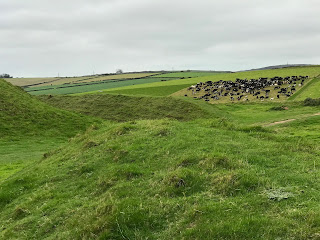When I was a very small boy, I loved drawing and (even better) colouring in pictures of Iron Age Celts with their splendid helmets and shields, their baggy tartan trews, long moustaches and braided hair (and they were just the women) Later I developed a passion for drawing Roman soldiers; and when the two came together in the Roman invasion of Britain, my joy was unbounded.
You need to understand this to appreciate my feelings for Maiden Castle. I took several parties of twelve-year-old children there longer ago than I care to remember. One bunch got carried away and charged down into a cornfield pretending they were Celts. The school received a complaint from the farmer the following day.
Maiden castle taken from the air. Like other Iron Age Hill forts those ramparts would have been even higher, topped by wooden stockades.
Vespasian did more than complain when he razed Maiden Castle in his 43 AD campaign. Its inhabitants were forcibly removed to what is now Dorchester about 2 miles away, and apart from a Roman temple of which only the foundations remain, Maiden Hill remained unoccupied, a mute reminder to a magical past—a bit like the Colosseum built by Vespasian when he later became emperor.
As it was then:
As you approach, it seems so much part of the landscape as to go almost unnoticed.
The name Maiden comes from the Celtic ‘Mae Dun’ or ‘Big Hill,’ and at the time of the Roman conquest was controlled by the Durotiges, a confederation of Celtic tribes. It had a much longer history before that, its early development beginning around 3000 BC. The present hillfort was built during the Iron Age between 450 – 300 BC. The fort area was extended to cover an area of 47 acres, equivalent to 50 football pitches. Its defences consisted of deep ditches – the earth removed and used to build the ramparts. A wooden stockade would have been erected on these ramparts which were already high enough—today about 20 ft high, then though much higher.
There is a weird, almost alien air as you walk through and between the maze like ditches.
I wish the weather had been better, the light more evocative because, to be honest, the photographs don’t evoke the experience of actually being there. Walking through and between ditches in a maze-like ascent to the top, brought with it an other-worldly experience— something never felt all those years ago with fifty school children in tow.
And from the edge you can see distant Dorchester where the original inhabitants were moved. No hills to climb, straight roads, and public baths. Luxury.
If you look closely, you'll see a green figure. I blinked and it vanished. Spooky.
It would be a wonderful thing to wander here at night or in mist. There are ghosts here, I’m sure, certainly there are bodies. Fifty-two burials were excavated in the late 1930’s some with horrifying war wounds, others buried in state complete with jewellery, weapons, and the occasional joint of meat.
Speaking of which, we had a cottage to go to, beer to drink, and something to eat.
















2 comments:
I often wonder about fields long abandoned on why trees and bramble never seem to grow there. Around me, you can't leave a patch undisturbed for long before some quick growing shrub or tree takes over.
Unless this vast hill is like the American prairies where constant winds and grazing animals only allow grasses to grow.
re: children in the corn
And where was their teacher? LOL! I'll admit as a 12 year old I probably couldn't have resisted charging into the corn either.
Their teacher was left in their wind-stream as they channelled their inner Celt. Thank God they didn’t have swords.
Ref grass, strategically placed sheep does the trick. Keep trying to persuade Bernadette we could do with a sheep to save me mowing the lawn. She’s not entirely convinced
Post a Comment